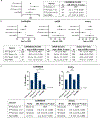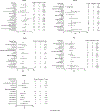Association of gene variant type and location with breast cancer risk in the general population
- PMID: 40288678
- PMCID: PMC12288856
- DOI: 10.1016/j.annonc.2025.04.010
Association of gene variant type and location with breast cancer risk in the general population
Abstract
Background: Pathogenic variants (PVs) in ATM, BRCA1, BRCA2, CHEK2, and PALB2 are associated with increased breast cancer risk. It is unknown, however, whether this risk differs by PV type or location in carriers ascertained from the general population.
Patients and methods: To evaluate breast cancer risks associated with PV type and location in ATM, BRCA1, BRCA2, CHEK2, and PALB2, we carried out age-adjusted case-control association analysis in 32 247 women with and 32 544 age-matched women without breast cancer from the CARRIERS Consortium. PVs were grouped by type and location within genes and assessed for risks of breast cancer [odds ratios (OR), 95% confidence intervals (CI), and P values] using logistic regression.
Results: Compared with women carrying BRCA2 exon 11 protein truncating variants (PTVs) in the CARRIERS population-based study, women with BRCA2 ex1-10 PTVs (OR = 13.5, 95% CI 6.0-38.7, P < 0.001) and ex13-27 PTVs (OR = 9.0, 95% CI 4.9-18.5, P < 0.001) had higher breast cancer risks, lower rates of estrogen receptor (ER)-negative breast cancer (ex13-27 OR = 0.5, 95% CI 0.2-0.9, P = 0.035; ex1-10 OR = 0.5, 95% CI 0.1-1.0, P = 0.065), and earlier age at breast cancer diagnosis (ex13-27 5.5 years, P < 0.001; ex1-10 2.4 years, P = 0.169). These associations with ER-negative breast cancer and age were replicated in a high-risk clinical cohort from Ambry Genetics and the population-based UK Biobank cohort. No differences in risk by gene region were observed for PTVs in other predisposition genes.
Conclusions: Population-based and clinical high-risk cohorts establish that PTVs in exon 11 of BRCA2 are associated with reduced breast cancer risk, later age at diagnosis, and greater risk of ER-negative disease. These differential risks may improve individualized risk prediction and clinical management for women carrying BRCA2 PTVs.
Keywords: breast cancer risk; pathogenic variant type and location; population-based cohort.
Copyright © 2025 The Authors. Published by Elsevier Ltd.. All rights reserved.
Figures


Update of
-
Association of Gene Variant Type and Location with Breast Cancer Risk in the General Population.medRxiv [Preprint]. 2024 Oct 12:2024.10.11.24315237. doi: 10.1101/2024.10.11.24315237. medRxiv. 2024. Update in: Ann Oncol. 2025 Aug;36(8):954-963. doi: 10.1016/j.annonc.2025.04.010. PMID: 39417132 Free PMC article. Updated. Preprint.
References
-
- Renwick A, Thompson D, Seal S, et al. : ATM mutations that cause ataxia-telangiectasia are breast cancer susceptibility alleles. Nat Genet 38:873–5, 2006 - PubMed
-
- Miki Y, Swensen J, Shattuck-Eidens D, et al. : A Strong Candidate for the Breast and Ovarian Cancer Susceptibility Gene BRCA1. Science 266:66–71, 1994 - PubMed
-
- Wooster R, Bignell G, Lancaster J, et al. : Identification of the breast cancer susceptibility gene BRCA2. Nature 378:789–792, 1995 - PubMed
MeSH terms
Substances
Grants and funding
- R01 CA225662/CA/NCI NIH HHS/United States
- 75N92021D00005/WH/WHI NIH HHS/United States
- P30 CA014520/CA/NCI NIH HHS/United States
- Z01 ES049033/ImNIH/Intramural NIH HHS/United States
- K12 CA090628/CA/NCI NIH HHS/United States
- 75N92021D00001/HL/NHLBI NIH HHS/United States
- P50 CA116201/CA/NCI NIH HHS/United States
- R35 CA253187/CA/NCI NIH HHS/United States
- U19 CA148065/CA/NCI NIH HHS/United States
- ZIA ES102245/ImNIH/Intramural NIH HHS/United States
- R01 CA192393/CA/NCI NIH HHS/United States
- R01 CA202981/CA/NCI NIH HHS/United States
- 75N92021D00002/HL/NHLBI NIH HHS/United States
- UL1 TR000445/TR/NCATS NIH HHS/United States
- Z01 ES044005/ImNIH/Intramural NIH HHS/United States
- P01 CA087969/CA/NCI NIH HHS/United States
- U01 CA164974/CA/NCI NIH HHS/United States
- R01 CA098663/CA/NCI NIH HHS/United States
- R01 CA097396/CA/NCI NIH HHS/United States
- UM1 CA176726/CA/NCI NIH HHS/United States
- 75N92021D00003/WH/WHI NIH HHS/United States
- UM1 CA186107/CA/NCI NIH HHS/United States
- R01 CA140286/CA/NCI NIH HHS/United States
- 75N92021D00004/WH/WHI NIH HHS/United States
LinkOut - more resources
Full Text Sources
Medical
Research Materials
Miscellaneous

